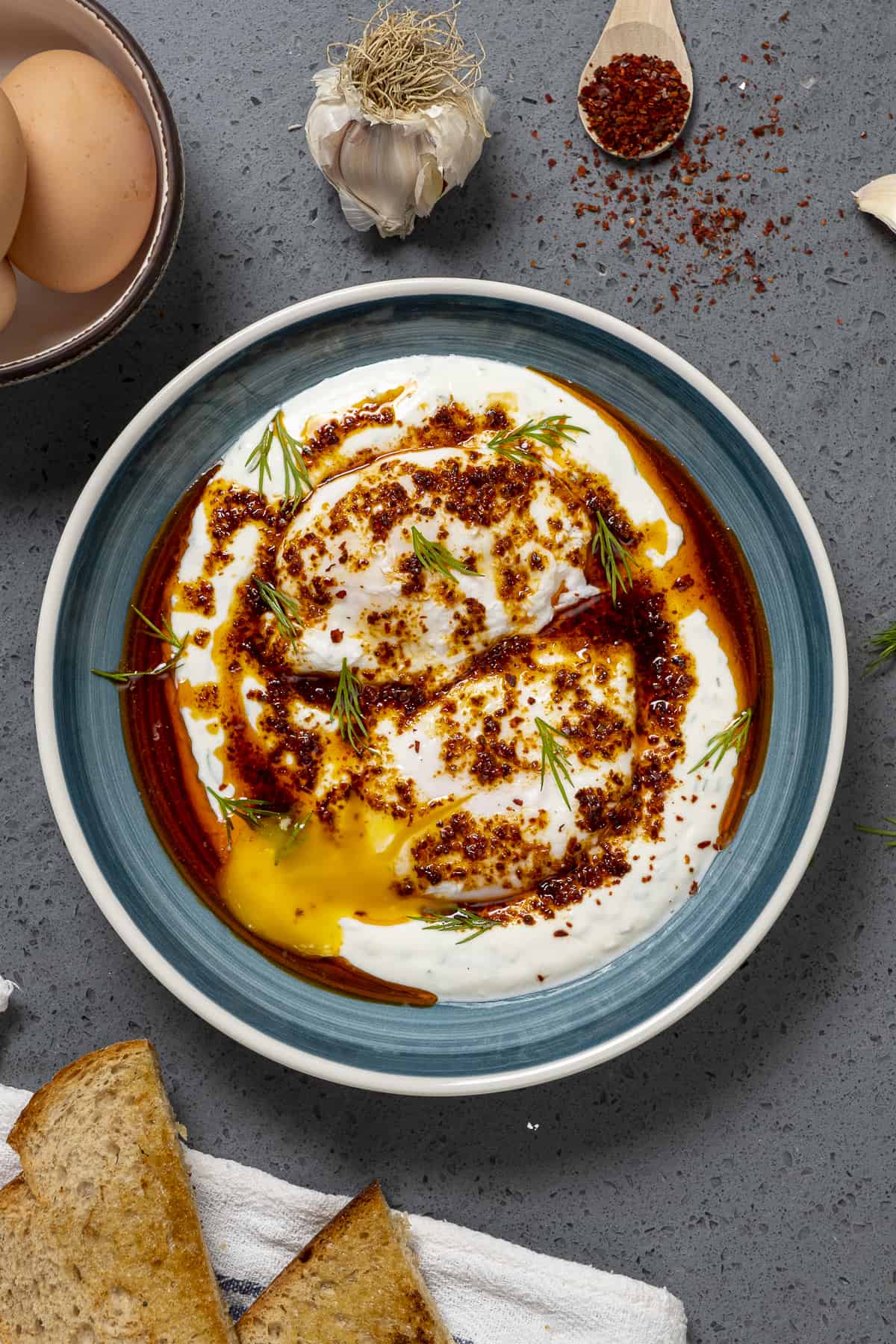Turkish Eggs Cilbir: Origins, Nutritional Benefits, and Global Comparisons
Turkish Eggs Cilbir dates back to the Ottoman Empire. Cookbooks from the 15th century document the dish, showcasing its long-standing presence in Turkish cuisine. Sultans favored Cilbir for its rich, nutritious ingredients, making it a staple in royal kitchens. The dish’s simplicity and flavor have helped it endure through centuries.
Regional Variations
Though Cilbir originated during the Ottoman era, regional variations have emerged over time. In some areas, the yogurt base features garlic or herbs like dill. Others incorporate regional spices such as Aleppo pepper or sumac to tailor the dish’s taste. Each variant of Cilbir maintains the primary combination of yogurt, poached eggs, and spiced butter while allowing for local adaptations.
Key Ingredients in Turkish Eggs Cilbir
Eggs and Yogurt
Eggs and yogurt form the foundation of Turkish Eggs Cilbir. Use fresh, high-quality eggs to achieve the best taste and texture. Poach the eggs until the whites are firm but the yolks remain runny. Turkish or Greek yogurt, known for its thick and creamy consistency, is ideal. It’s rich in probiotics, making it both delicious and healthy. Before serving, mix the yogurt with salt and garlic, if desired, to enhance its flavor.
Herbs and Spices
Herbs and spices elevate the flavor profile of Cilbir. Common choices include dill, mint, and parsley. These herbs, fresh and finely chopped, add a burst of freshness to the dish. Spices like Aleppo pepper or sumac provide a mild heat and tangy note. Drizzle the finished dish with spiced butter, typically made by melting butter and infusing it with paprika or chili flakes. This combination creates a harmonious balance of flavors that defines Turkish Eggs Cilbir.
How to Make Turkish Eggs Cilbir
Preparing the Yogurt Base
To prepare the yogurt base, start with thick Greek or Turkish yogurt. Ensure it’s fresh and rich in probiotics for optimal flavor and health benefits. In a bowl, mix the yogurt with grated garlic and a pinch of salt. Whisk until smooth and creamy. Adding chopped fresh herbs like dill or mint enhances the taste further.
Poaching the Eggs
For perfectly poached eggs, boil water in a large pan. Add a splash of vinegar to help the egg whites set faster. Crack each egg into a small bowl, then gently slide it into the simmering water. Cook for 3-4 minutes until the whites are firm but the yolks remain runny. Use a slotted spoon to remove the eggs and let them drain on a paper towel.
Making the Chili Butter
To make the chili butter, melt unsalted butter in a small pan over medium heat. Once it starts to foam, add Aleppo pepper or chili flakes. Stir for a few minutes until the butter turns a deep golden-orange color. This spiced butter, with its smoky and slightly spicy flavor, is essential for authentic Turkish Eggs Cilbir. Pour it over the poached eggs and yogurt base when serving.
By following these steps, you’ll create a delicious and traditional Turkish Eggs Cilbir, rich in history and flavor.
Serving and Pairing Suggestions
Traditional Garnishes
Traditional garnishes enhance Turkish Eggs Cilbir and add depth to the dish. Common garnishes include fresh dill, mint, and parsley. These herbs bring a burst of freshness and color, complementing the rich yogurt and butter.
Sprinkle crumbled feta cheese over the Cilbir to add a salty contrast. A light dusting of Aleppo pepper or sumac gives a zesty note. Try adding toasted sesame seeds or a drizzle of extra virgin olive oil for extra texture and richness.
Suitable Accompaniments
Suitable accompaniments balance Turkish Eggs Cilbir’s rich flavors. Serve with warm, crusty bread like pita or sourdough for dipping. The bread absorbs the creamy yogurt and spiced butter. Including sliced cucumbers and tomatoes adds a refreshing crunch.
Match Cilbir with a simple side salad of greens, red onion, and lemon vinaigrette. The acidity from the vinaigrette cuts through the richness of the eggs and yogurt. Consider serving black or green olives for an added Mediterranean touch.
For a complete meal, pair Cilbir with traditional Turkish tea or a glass of chilled white wine, like Sauvignon Blanc, which complements the dish’s flavors.
Nutritional Benefits of Turkish Eggs Cilbir
Protein and Probiotic Content
Turkish Eggs Cilbir combines high-quality proteins and probiotics. Eggs provide about 6 grams of protein each, promoting muscle repair and growth. Yogurt offers probiotics, beneficial bacteria that support gut health. Together, these components contribute to a balanced diet, enhancing your overall wellness.
Considerations for a Balanced Meal
Include Turkish Eggs Cilbir in a balanced meal for optimal nutrition. Pair it with whole grains like bread and fresh vegetables. This combination ensures a mix of macronutrients and essential vitamins, supporting sustained energy and a comprehensive nutrient intake. Adding these accompaniments maximizes the dish’s health benefits while keeping it flavorful.
Comparison with Other Egg Dishes
Turkish Eggs Cilbir vs. Shakshouka
Turkish Eggs Cilbir offers a rich blend of yogurt, poached eggs, and spiced butter, creating a creamy, savory experience. Shakshouka, on the other hand, features poached eggs in a tomato and bell pepper sauce, making it a more vibrant and spicy dish. Cilbir centers on the cooling effect of yogurt balanced with the heat of spiced butter, while Shakshouka emphasizes the zest of tomatoes and the smoky essence of peppers. The choice of herbs also varies: Cilbir uses dill, mint, and parsley, but Shakshouka leans towards cilantro and parsley. Both dishes utilize poached eggs, yet their base and flavor profiles differ significantly, offering distinct culinary experiences.
Turkish Eggs Cilbir vs. Eggs Benedict
Comparing Turkish Eggs Cilbir to Eggs Benedict highlights the diverse uses of poached eggs. Cilbir’s foundation lies in tart yogurt and spiced butter, whereas Eggs Benedict features a toasted English muffin, ham or bacon, and rich hollandaise sauce. Cilbir brings a Middle Eastern flavor with probiotics and spices, while Eggs Benedict delivers a Western breakfast experience with buttery and creamy textures. Both are indulgent, yet Cilbir offers a lighter, probiotic-rich option contrasted with the rich, buttery profile of Eggs Benedict.
Turkish Eggs Cilbir vs. Huevos Rancheros
Turkish Eggs Cilbir and Huevos Rancheros both elevate breakfast eggs but through different cultural lenses. Cilbir pairs poached eggs with creamy yogurt and spiced butter, offering a savory, indulgent flavor. Huevos Rancheros involves fried eggs served with tortillas, beans, and a spicy tomato-chili sauce, providing a hearty, robust taste. Cilbir benefits from the balancing act of cool yogurt and spices, while Huevos Rancheros relies on beans, cheese, and salsa for a complex flavor. Both breakfasts are nourishing but cater to different palate preferences.
Turkish Eggs Cilbir vs. Omelette
The fundamental differences between Turkish Eggs Cilbir and an omelette lie in preparation and ingredients. Cilbir uses poached eggs with yogurt and spiced butter, delivering a unique Middle Eastern flavor. An omelette involves beaten eggs cooked with fillings like cheese, vegetables, and meats. Cilbir capitalizes on the contrast between cool yogurt and warm spiced butter, while an omelette provides a customizable approach with various savory fillings.
Conclusion
Turkish Eggs Cilbir offers a delightful blend of flavors and textures that can elevate your breakfast or brunch experience. This dish isn’t just a feast for your taste buds but also a nutritious option packed with high-quality proteins and probiotics. Whether you’re a fan of traditional recipes or looking to explore new culinary horizons, Cilbir provides a unique and satisfying option.
Pair it with whole grains and fresh vegetables for a balanced meal, and don’t hesitate to experiment with different herbs and spices to suit your palate. Next time you’re in the mood for something special, give Turkish Eggs Cilbir a try and enjoy its rich cultural heritage and delicious taste.






